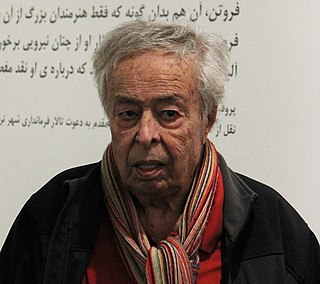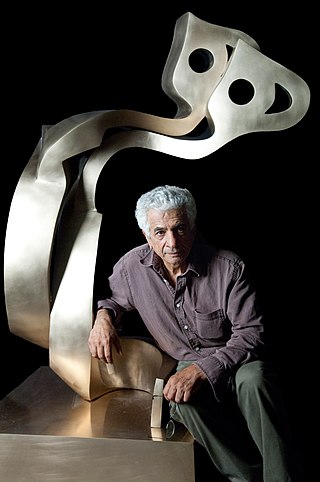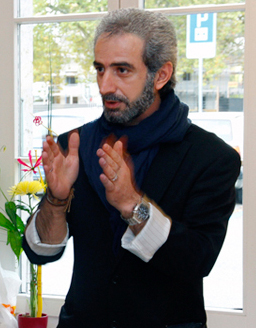Related Research Articles

Takashi Murakami is a Japanese contemporary artist. He works in fine arts media as well as commercial and is known for blurring the line between high and low arts as well as co aesthetic characteristics of the Japanese artistic tradition and the nature of postwar Japanese culture and society, and is also used for Murakami's artistic style and other Japanese artists he has influenced.

Mohsen Vaziri Moghaddam, was an Iranian-born painter, sculptor, and a professor of art. He was most notable for his style of abstract expressionism, and was once referred to as the "pioneer of modern Iranian abstraction."
A cursory glance at the history of art reveals that social, political and economic conditions have always played a major role in the emergence of new artistic currents and styles. As an example Flight by Morteza Katouzian is showing the marginalized people who have no freedom as result of political changes. In Iran, the social and political developments of the 1940s radically altered the evolution of this country's plastic arts and entirely altering its natural path.
Aya Takano is a Japanese painter, Superflat artist, manga artist, and science fiction essayist. Aya Takano is represented by Kaikai Kiki, the artistic production studio created in 2001 by Takashi Murakami.

Parviz Tanavoli is an Iranian sculptor, painter, educator, and art historian. He is a pioneer within the Saqqakhaneh school, a neo-traditionalist art movement. Tanavoli has been one of the most expensive Iranian artists in sales. Tanavoli series of sculpture work Heech are displayed in prestigious museums and public places, such as the British Museum, Metropolitan Museum of Art, Hamline University, Aga Khan Museum, and as public art in the city of Vancouver. Additionally Tanavoli has written extensively on this history of Persian art and Persian crafts. Since 1989, Tanavoli has held dual nationality and has lived and worked both in Tehran, and Horseshoe Bay in West Vancouver, British Columbia.
Mohammad Ali Taraghijah was an Iranian painter, his work often featured rural, Iranian, landscape imagery.

Farhad Fakhreddini is a renowned Iranian composer, conductor and founder of Iran’s National Orchestra.

Jin Meyerson is an American artist previously based in Brooklyn, New York, later dividing his time between Paris and Seoul.
Charles Hossein Zenderoudi is an Iranian painter, calligrapher and sculptor, known as a pioneer of Iranian modern art and as one of the earliest artists to incorporate Arabic calligraphy elements into his artwork. He is a pioneer of the Saqqa-Khaneh movement, a genre of neo-traditional modern art found in Iran that is rooted in a history of coffee-house paintings and Shia Islam visual elements. He lives in Paris and New York.

Towhidi Tabari is an Iranian artist.

Farhad Sadeghi Amini, born in Isfahan, Iran, 1963 is an Iranian painter.
Qorban Ali Ajalli Vaseq is a master calligrapher, painter, poet and educator, noted for founding the "Gol Gasht" style of calligraphy, characterised by a dense and interlocking play of the Arabic script, a distinctive style now regularly used by Arab and Iranian calligraphers in artworks.
Emmanuel Perrotin is the French contemporary art gallery owner of Galerie Perrotin.

Perrotin is a contemporary art gallery founded in 1990 by Emmanuel Perrotin, at the age of twenty-one. He has since opened over eighteen spaces.
Pouran Jinchi is an Iranian-American, New York-based artist. She is best known for her abstract, calligraphy-based contemporary visual art.
Rokni Haerizadeh is an Iranian artist living and working in Dubai. He participated in the Carnegie International in 2013.

Shirin Aliabadi was an Iranian contemporary multidisciplinary visual artist whose work focused on women's issues, gender representation, and the beauty industry. She is best known for depiction of rebellious Iranian women in her Girls in Cars and Miss Hybrid series of photographs.
Golnaz Fathi is an Iranian contemporary artist noted for her artwork in the hurufiyya tradition.

Hiwa Pashaei or Hiva Pashaei is a Kurdish painter, photographer, calligrapher, graphist, curator and publisher from Iran, living in the United States. He is active in the fields of painting, graphic design, research and education of visual arts. Pashaei is known for his spearhead role in pixel art in Iran and Kurdistan. Pashaei is also renowned because of his innovative use of Kurdish culture themes, specially culture of Kermanshah region Kurds, creating figurative works with the subject of Kurdish women, and presenting these themes in the form of modern and post modern art. He is manager of Rouge Art Gallery and Founder of Jowan Visual Art School in Tehran, and also CEO & Founder of Art & Culture Center of California "ACCC" in Los Angeles. Pashaei has held several individual and group exhibitions in Iran and other countries like Iraq, Japan, Italy, France and United States.
Faramarz Pilaram was an Iranian painter and educator. He is known for his abstract, and calligraphy-based modern paintings. Pilaram was a pioneer within the Saqqakhaneh school, a neo-traditionalist art movement. There were three major periods in his artistic career: figurative, decorative and calligraphic.
References
- 1 2 "Farhad Moshiri Biography". artnet.com. Retrieved 2016-05-14.
- ↑ "Farhad Moshiri (Iranian, b. 1963), Secret Garden". Christie's. Retrieved 2016-05-14.
- ↑ "Sotheby's Staging Comprehensive Middle East Art Auction". Voice of America (VOA). Retrieved 2016-05-14.
- ↑ "Farhad Moshiri". ArtTactic.com. Archived from the original on 2014-07-16. Retrieved 2016-05-14.
- ↑ "Art Gallery Dubai". The Third Line. Retrieved 2016-05-14.
- ↑ Seaman, Anna (2016-02-01). "Room to grow: How The Third Line raised the bar for art in the Middle East". The National . Retrieved 2016-05-14.
- ↑ "Emmanuel Perrotin Opens New Gallery in Seoul". Artinfo. Retrieved 2016-05-14.